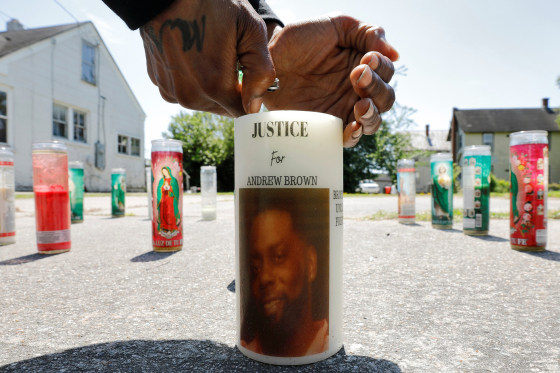Department policy for the sheriff's office in the North Carolina county where deputies fatally shot Andrew Brown Jr. as he was driving says shooting at moving vehicles is "rarely effective" and should be only a last resort to avoid an "imminent threat."
The shooting also raised concerns from a retired police lieutenant in Boston and a retired police chief from New Jersey, who said the deputies' use of lethal force generally runs counter to best practices.
Brown, 42, was killed last week in Elizabeth City as Pasquotank County sheriff's deputies sought to arrest him on drug charges.
District Attorney Andrew Womble said in court Wednesday that Brown made contact with officers while reversing his vehicle and then moving forward, prompting deputies to fire at him. But the sheriff's office policy, dated April 9 and uploaded to the county's website, directs deputies to try to avoid firing their weapons under such circumstances.
"Shots fired at or from a moving vehicle involve additional considerations and risks, and are rarely effective," the policy states. "When feasible, deputies should take reasonable steps to move out of the path of an approaching vehicle instead of discharging their firearm at the vehicle or any of its occupants."
The policy also makes it clear that a deputy "should only discharge a firearm at a moving vehicle or its occupants when the deputy reasonably believes there are no other reasonable means available to avert the imminent threat of the vehicle, or if deadly force other than the vehicle is directed at the deputy or others."
Another part of the nine-page policy, which covers many scenarios that could lead deputies to fire their weapons, said every potential deadly encounter is unique.
"The reasonableness of force will be judged from the perspective of a reasonable deputy on the scene at the time of the incident. Any evaluation of reasonableness must allow for the fact that deputies are often forced to make split-second decisions about the amount of force that reasonably appears necessary," the policy states. "Given that no policy can realistically predict every possible situation a deputy might encounter, deputies are entrusted to use well-reasoned discretion in determining the appropriate use of force in each incident."
Former police supervisors said Brown's death merits further investigation because it is industry standard to hold fire even if a suspect is using a vehicle as a weapon. The longtime officers said shootings into vehicles can have tragic results and tend to put the lives of officers, the public and suspects in danger.
Brian Higgins, retired chief of the former Bergen County Police Department in New Jersey, said Brown's fatal shooting should be scrutinized. (The county police department recently merged with the county sheriff's office.)
"The general rule is you don't shoot at moving vehicles," said Higgins, an adjunct lecturer at the John Jay College of Criminal Justice at the City University of New York. "It still warrants a deeper investigation. ... Every time you do it, it's the exception."
The FBI said this week that it would open a federal civil rights investigation. A private autopsy commissioned by Brown's family determined that he was shot five times, including a fatal shot to the back of his head.
A judge ruled Wednesday that video from four deputies' body cameras would not be released to the public yet but said Brown's immediate relatives and their attorney would be able to view it within 10 days.
At the hearing, Womble, the district attorney, said Brown's vehicle made contact with officers twice.
"As it backs up, it does make contact with law enforcement officers," Womble said. "At this point, the car is stationary. There is no movement, and officers are positioned around the car. The next movement of the car is forward. It is in the direction of law enforcement and makes contact with law enforcement. It is then and only then that you hear shots."
Retired Lt. Thomas Nolan, a 27-year veteran of the Boston Police Department, said departments in the late 1990s and early 2000s began revisiting their deadly force policies pertaining to moving vehicles. He said many departments now urge officers to just step out of the way, even if a suspect uses the vehicle as a weapon.
Police are generally authorized to shoot into moving vehicles only in the rare instances when suspects shoot or threaten to shoot from inside, he said.
"We have yet another deadly force incident involving a Black man. We have no indication Mr. Brown was armed," said Nolan, an associate professor of sociology at Emmanuel College in Boston. "Language is contained in most of these policies that says the moving vehicle itself shall not constitute a dangerous or deadly weapon.
"If the contention in North Carolina is that somehow this vehicle was a dangerous weapon, that flies in the face of generally accepted practices, as well as commonly understood rules and procedures," he said.
Womble did not immediately respond to a request for comment.
Pasquotank County Sheriff Tommy Wooten and Chief Deputy Daniel Fogg did not return multiple emails Wednesday seeking comment. Representatives of the Pasquotank County District Attorney's Office also could not be reached.
Authorities have not said whether any officers were injured or how fast Brown's vehicle was traveling when, they say, it made contact with officers.
Wooten said in a statement after the hearing Wednesday that he wanted the body-camera video to be released to the public as soon as possible.
"I'm disappointed it won't happen immediately," he said. "Obviously, I'll respect the judge's ruling. Although we're unable to show the public what happened right now, the independent investigators are working to complete their investigation. As soon as all of the important facts are given to me, I will act quickly to ensure accountability, and I'll be as transparent as I possibly can with the public."
